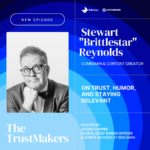By Sophia Cao, Director of Private Advertising Advocacy – RTB House
E-commerce isn’t just growing — it’s booming. Each year, more consumers shift their shopping habits online, and all signs point to continued momentum well into 2028. Digital shelves are expanding, competition is intensifying, and brands are stepping up their game to capture every possible sale.
But alongside this growth comes a critical shift: access to the data that once fueled digital advertising is in flux. Privacy regulations, browser changes, and rising consumer expectations are reshaping how brands reach, influence, and convert shoppers.
The pace of change may be uneven – two steps forward, one step back- but the privacy-centric digital world is already here. The strongest path forward is building on what lasts, and that means first-party advertising.
Consumers Are Paying Attention to Privacy
Consumer awareness around data privacy has grown steadily over the past two decades. From the early days of the World Wide Web to headline-making data breaches involving household names like Myspace, Cambridge Analytica, and Equifax, public consciousness around data use has changed dramatically. Customers expect transparency, control, and responsibility from the brands they engage with.
That awareness has shifted behavior. More consumers now use privacy tools, opt out of tracking when asked, and choose platforms and services based on how their data is handled. Upcoming changes from Google in Chrome will accelerate this shift. For advertisers, this means adapting to a reality where consumer privacy is a core requirement, not a nice-to-have.
Regulators Are Catching Up
In response to this growing concern, 19 U.S. states have passed comprehensive data privacy laws, with at least five more actively moving legislation forward. Globally, more than 120 countries have implemented data protection regulations. Compliance is no longer a checkbox – it’s an operating standard.
This regulatory momentum adds complexity, especially for brands active across multiple states or regions. But more importantly, it signals permanence. Privacy requirements aren’t a passing trend – they’re now foundational to how digital advertising works.
Platforms Are Playing Their Own Game
But perhaps the strongest indicator that the privacy-centric digital world is here to stay comes from Big Tech. Apple made the first major move with Intelligent Tracking Prevention (ITP) in Safari in 2017, followed by App Tracking Transparency (ATT) in 2021. These weren’t just user protections – they were competitive plays.
Meta followed a different path – building a self-contained “content fortress” that keeps user data inside its walled garden. And Google is carefully balancing privacy concerns with its own advertising interests by introducing its initiative in Chrome – the Privacy Sandbox.
Platforms aren’t simply responding to privacy pressures – they’re shaping them, using privacy as both a marketing message and a competitive weapon. The result? A more fragmented advertising landscape where brands must take greater ownership of their data strategy to stay in control.
First-Party Advertising powered by Next Gen Tech
It’s become increasingly clear that first-party advertising is the most reliable path forward. It harnesses first-party signals and data gathered from direct customer interactions without relying on personally identifiable information like emails, phone numbers, or loyalty programs, which are typically used in owned channels. First-party advertising has always held potential, but until recently, it had limits.
What sets it apart now is how next-generation advertising technology, like Deep Learning, transforms what first-party strategies can achieve. Unlike legacy methods, Deep Learning uncovers hidden behavioral patterns that others miss. It understands intent and adapts in real time to changing conditions, consistently learning and improving targeting and personalization.
These insights help brands identify non-obvious converters and address complex-paths-to purchase, secure stronger ad placements, and display shoppable creative that inspire action. Deep Learning enables brands to make novel product recommendations, drive incremental revenue, and turn customer interaction data into a powerful performance engine at scale.
In a fragmented, fast-moving market, it’s how brands claim their fair share of growth and stay one step ahead. And we’re seeing it work. Brands that layer Deep Learning onto standard performance marketing approaches are unlocking 57% added scale for conversion and acquisition tactics. In fact, 61% of purchases driven by Deep Learning-powered First-party Advertising come from products consumers had never viewed before. That’s proof that this next-generation tech activates first-party signals, delivering a real impact at scale.
Building on What Lasts
A privacy-centric world isn’t coming—it’s already here. And in this new, more complex reality, brands can’t rely on yesterday’s playbook. They need to invest in what lasts to compete effectively and drive transactions at scale.
That means shifting focus from borrowed signals to owned ones and guarding them. It means leveraging next-generation tech to activate them. And, above all, it means making first-party advertising the foundation of long-term strategy.











